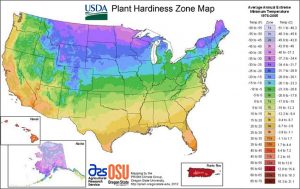Plant Hardiness Zone Map
The USDA Plant Hardiness Zone Map is the standard by which gardeners and growers can determine which plants are most likely to thrive at a location, click here for the interactive map .

The United States Department of Agriculture (USDA) developed the first hardiness zone map in 1960, which has since been updated several times. The current USDA Plant Hardiness Zone Map, last updated in 2012, is based on 30 years of weather data collected from 1976-2005.
Plant hardiness zones are a useful tool for gardeners and horticulturists alike, helping them to determine which plants are most likely to thrive in their particular climate. A plant hardiness zone is a geographic area defined by its average minimum temperature during the winter months. These zones are typically divided into 10-degree Fahrenheit increments, ranging from Zone 1 (the coldest) to Zone 13 (the warmest).
For example, Zone 1, which includes parts of Alaska and northern Canada, experiences average minimum temperatures of -60 to -50 degrees Fahrenheit while Zone 13, which includes southern Florida and Hawaii, experiences average minimum temperatures of 60 to 70 degrees Fahrenheit.
Recently, each Zone has been categorized into 2 distinct “adjacent zones”. In general, the difference between adjacent zones is about 5°F. For example, Zone 7a has a minimum temperature range of 0°F to 5°F, while Zone 7b has a minimum temperature range of 5°F to 10°F.
Reading the Plant Hardiness Zone Map is relatively straightforward. The map is color-coded, with each color representing a different hardiness zone. You can find your hardiness zone by locating your area on the map and identifying the color that corresponds to that zone.
It’s important to note that the hardiness zones are based solely on minimum temperatures and do not take into account other factors that may affect a plant’s ability to thrive in a particular climate. Other factors such as soil type, rainfall, and humidity can all have a significant impact on a plant’s health and should also be taken into consideration when choosing plants for your gardens.